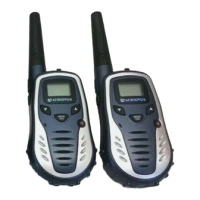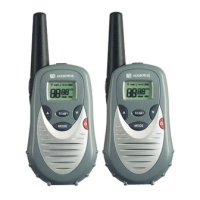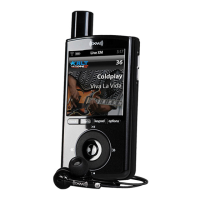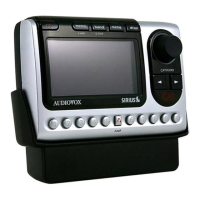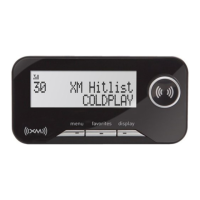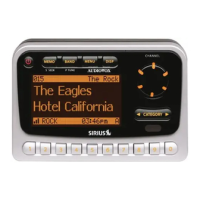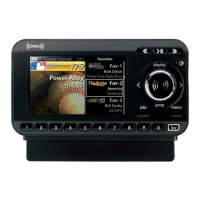Do you have a question about the Audiovox GMRS6000-2PK and is the answer not in the manual?
Guidelines for maintaining compliance with RF exposure limits for handheld devices.
Factors affecting radio performance and range, including environmental influences.
Instructions for safe battery care, charging, and environmentally sound disposal.
Information on FCC compliance, warnings, and the requirement for a GMRS license.
List of items included in the GMRS6000-2PK bonus pack.
Details on how to power the transceiver using alkaline or rechargeable batteries.
Information on charging rechargeable batteries and battery type compatibility.
Basic steps for operating the radio in GMRS/FRS modes.
Description of the main buttons and their functions for basic operation.
How to adjust volume levels and use the display backlight feature.
Function of the Monitor button for checking channel activity.
How to use the Push-To-Talk button for transmitting and receiving.
Using channel/volume buttons for adjustments in standby and edit modes.
Functions of the MODE button for settings and the SCAN button to monitor channels.
Description of the jack for external microphone, headset, and charger.
Steps for turning on the radio and initiating communication.
How to select channels and understand FRS/GMRS channel assignments.
Procedure for changing the radio's channel using the MODE button.
How to select CTCSS sub-channels for filtered communication.
How to enable or disable the Roger Beep tone notification.
Setting up voice-activated transmission for hands-free communication.
Information about the button beep confirmation tone feature.
How to activate the call ring melody for incoming calls.
How to enable and use the channel scanning feature to find signals.
Understanding the battery icon and when to recharge or replace batteries.
Tips for clear transmission, avoiding interference, and maximizing battery life.
Details on frequency range, channel spacing, dimensions, and power supply.
Technical specifications for the receiver and transmitter components.
A table listing main channels, types, and their corresponding frequencies.
Guidelines for maintaining compliance with RF exposure limits for handheld devices.
Factors affecting radio performance and range, including environmental influences.
Instructions for safe battery care, charging, and environmentally sound disposal.
Information on FCC compliance, warnings, and the requirement for a GMRS license.
List of items included in the GMRS6000-2PK bonus pack.
Details on how to power the transceiver using alkaline or rechargeable batteries.
Information on charging rechargeable batteries and battery type compatibility.
Basic steps for operating the radio in GMRS/FRS modes.
Description of the main buttons and their functions for basic operation.
How to adjust volume levels and use the display backlight feature.
Function of the Monitor button for checking channel activity.
How to use the Push-To-Talk button for transmitting and receiving.
Using channel/volume buttons for adjustments in standby and edit modes.
Functions of the MODE button for settings and the SCAN button to monitor channels.
Description of the jack for external microphone, headset, and charger.
Steps for turning on the radio and initiating communication.
How to select channels and understand FRS/GMRS channel assignments.
Procedure for changing the radio's channel using the MODE button.
How to select CTCSS sub-channels for filtered communication.
How to enable or disable the Roger Beep tone notification.
Setting up voice-activated transmission for hands-free communication.
Information about the button beep confirmation tone feature.
How to activate the call ring melody for incoming calls.
How to enable and use the channel scanning feature to find signals.
Understanding the battery icon and when to recharge or replace batteries.
Tips for clear transmission, avoiding interference, and maximizing battery life.
Details on frequency range, channel spacing, dimensions, and power supply.
Technical specifications for the receiver and transmitter components.
A table listing main channels, types, and their corresponding frequencies.
| Channels | 22 |
|---|---|
| Privacy Codes | 38 |
| Battery Life | Up to 12 hours |
| Weather Radio | Yes |
| Call Tones | 10 |
| VOX | Yes |
| Water Resistance | IPX4 |
| Type | GMRS |
| Power Output | 5 Watts |
